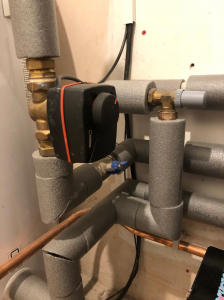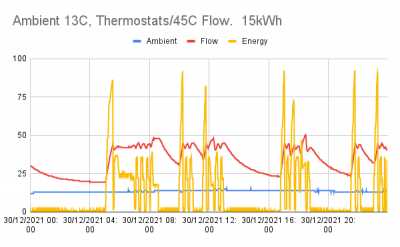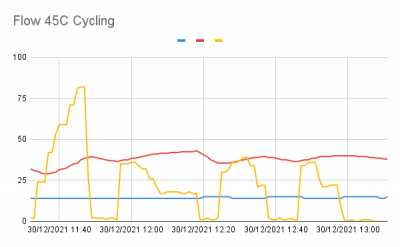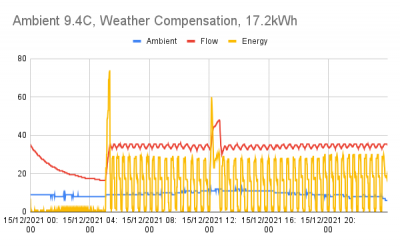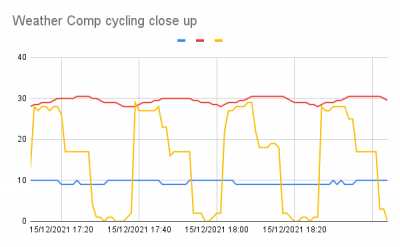The auto bypass is located just after the 3 port valve, before any of the radiators. A quick google search suggests it should be located further in to the central heating circuit. I think it has been put here for ease of access rather than any other reason. I'm not sure why it's even needed, I have a towel rail in the bathroom which is one of the further radiators from the heat pump, and I now have all the TRV's fully open, so I would have thought that would be a sufficient circuit to not require an auto bypass valve. I have left it alone so far. Picture of the valve below.
Thanks for looking over the report. I was going around in circles a bit with the report too but didn't know if it was me and my limited technical understanding of the subject.
From personal experience of the last two weeks I'm sticking with the method of running with weather compensation, slow and steady, the house is much more comfortable. I'd like to try Leaving Water Temperature Modulation if I can convince the installer to move the controller. I'd just like to reduce the cycling further if possible.
Hi @kev-m
A quick question I am hoping you can answer.
Because of the mild weather we are suffering at the moment, I assume that your heat pump is cycling?
How frequent is the cycling and for how long does your heat pump run?
@hydros Thats going to cause problems for sure. I would remove it completely. Easy enough to do, just get a couple of 22mm compression end caps and remove it. So long as you leave the Towel rad(s) open it will be fine.
Also, check the diverter valve has been setup correctly. Those valves have a number of options and its easy to get it wrong, if its not setup as a diverter it can act as a mid pos which I have seen a few times.
Just had annother quick look at the diagram, you have a volumiser and a BUH. I don't wire the BUH to run ever. It should be a last resort and frankly an inline 3kW heater is going to do very little. What it can do though is get stuck on or cycle if the ASHP control isn't quite right. This can cause issues, mostly with run cost but also it can mess with the lower modulation point of the ASHP as you have a fixed input on a modulating system. If you can disable it via an isolator I would do that too.
Internationally recognised award winning installer of heat pumps and stuff
Posted by: @derek-mHi @kev-m
A quick question I am hoping you can answer.
Because of the mild weather we are suffering at the moment, I assume that your heat pump is cycling?
How frequent is the cycling and for how long does your heat pump run?
Hi Derek,
Yes it does cycle. I'm currently not using weather compensation so yesterday looked like this. You can see the flow drop as the thermostats stop the ASHP.
Close up
When I was using weather compensation, a mild day looked like this. The peak in the middle is HW.
Close up
So it looks like 3 times per hour or so.
Hi @kev-m
Thanks for that Kev. It would appear that you are already doing something that I was going to suggest.
Running the system on thermostat control, rather than weather compensation, when the weather is milder. In that way the amount of cycling should be reduced and I suspect it will also reduce energy consumption.
Looking forward to seeing your results when you have completed your tests.
Posted by: @derek-mWhen operating on weather compensation, the thermostat should be set above the desired temperature, so that it does not switch off your heat pump prematurely.
@derek-m, I have a question about this statement. I think I understand your later explanation of how premature shutoff happens (link) but I don't understand why this situation is any different with weather compensation versus without. Why is this not an issue all the time? Also, how much higher should a thermostat be set to compensate for this?
Posted by: @jonathansPosted by: @derek-mWhen operating on weather compensation, the thermostat should be set above the desired temperature, so that it does not switch off your heat pump prematurely.
@derek-m, I have a question about this statement. I think I understand your later explanation of how premature shutoff happens (link) but I don't understand why this situation is any different with weather compensation versus without. Why is this not an issue all the time? Also, how much higher should a thermostat be set to compensate for this?
Hi Jonathans,
In weather compensation mode, the ASHP controller is stopping and starting the heat pump, rather than the thermostat. Dependent upon the outside air temperature, the ASHP controller will calculate the required water flow temperature that meets the present heat demand, and in this way the heat pump operates more efficiently.
When controlling the indoor air temperature using thermostats, the water flow temperature has to be at a higher value, to compensate for the periods when the heat pump is switched off and hence not supplying any heat energy. This higher value could be a few degrees or +20C, the thermostat will still switch the heat pump off when the set temperature has been reached.
If you try to operate your system with both the controller and the thermostats trying to control the temperature, then it probably will not perform very well.
The choice is therefore, to control your system on weather compensation, and set the thermostats 1C or 2C above the desired temperature, so that they don't normally interfere with the controller. This would probably be the best mode of operation when the outdoor air temperature is below +7C.
At the moment I am researching a possible alternative method of control, for milder weather conditions, to try to reduce compressor cycling. This method would involve using the weather compensation offset, to increase the water flow temperature by 1C or 2C, but then set the thermostats to control the indoor temperature at the desired level. Provided that the water flow temperature is sufficient to meet the heat demand, the desired indoor air temperature will be achieved and the thermostats will switch the heat pump on and off. This should reduce compressor cycling but still provide good overall efficiency.
I believe that Kev is already carrying out tests along these lines, so we should welcome any results he may have available.
Thanks very much -- I think I understand this now, as well as the source of my confusion. My Vaillant 12kW operates only w/the Vaillant Sensocomfort controller, ie, it has no other independent thermostat. So if I grasp your explanation, this means that even under weather compensation, I would use that controller as usual. That is, I would set a set-back temperature and then any other higher-heat demand periods (this is what I mean by 'as usual' -- putting in exactly the desired temperature rather than something slightly higher), initiate the function that adjusts the flow temp based on the current room temp, and then just let the ASHP run itself & adjust flow temps as it sees fit.
Have I correctly grasped the difference between the ASHP controller and the thermostat in your explanation?
I am getting ready to go out this evening, so will have a detailed look tomorrow and get back to you.
@derek-m, have a super evening. Best wishes to you and the Mrs. for 2022, and thank you for all your research, work and effort in helping homeowners with their heat pumps. Massively appreciated.
Get a copy of The Ultimate Guide to Heat Pumps
Subscribe and follow our YouTube channel!
-
Where has Watson gone?
3 weeks ago
-
First time wall mounting an ASHP
1 month ago
-
How can I programme a setback for my Samsung Gen6 8kW heat pump?
2 months ago
-
Rodents! A word of warning for heat pump owners
2 months ago
-
Retrofitting: moving to ASHP old oil boiler in large old property - experience/advice please on MSC calcs
3 months ago
- 26 Forums
- 2,342 Topics
- 53 K Posts
- 259 Online
- 6,000 Members
Join Us!
Worth Watching
Latest Posts
-
RE: Commencing on an ASHP Installation Process
I prepared this analysis for a post on another forum (a...
By Sheriff Fatman , 4 hours ago
-
RE: LiFePO4 lithium battery fires and explosions
Yes, more than an adjustment... This is the only comb...
By Batpred , 5 hours ago
-
RE: Poll for Time of Use, tariffs, technology
@old_scientist Interesting point, but I suspect that's ...
By Sheriff Fatman , 6 hours ago
-
RE: Different dT on each radiator?
I cant sorry. Its based on some calculations I did fro...
By JamesPa , 8 hours ago
-
RE: Setback savings - fact or fiction?
Maybe this: or maybe that the effect you are seein...
By JamesPa , 9 hours ago
-
RE: Help me keep the faith with my air source heat pump installation
@simonf thats interesting as I’ve noticed my flow and r...
By AdamK , 17 hours ago
-

RE: MELcloud scheduling misbehaviour
No, it gets to set temperature easily even during perio...
By Abernyte , 18 hours ago
-
RE: Free Ecoheat Heat Pump Install
Sorry hit 'add reply' too early, this forum layout will...
By Deltona , 19 hours ago
-
And arguably even more important, sodium will be hopefu...
By Batpred , 22 hours ago
-
RE: A Smarter Smart Controller from Homely?
I've been thinking of emailing Homely to ask for a few ...
By JohnnyB , 1 day ago
-
Max output of Heat pump (Daikin 4Kw EDLA04)
Hello, I am a bit puzzled that according to pcdb tes...
By GeorgeA , 1 day ago
-

In that case, @technogeek, I’d sign up for the free sol...
By Majordennisbloodnok , 1 day ago
-

RE: Has Anyone Else Noticed a Decline in Tradesmanship?
@cathoderay Hence my rider about ‘all else being equal’...
By Toodles , 1 day ago
-

RE: Heat Pump Performance Analysis Web App using Modbus Data
@redzer_irl — all my heat pump data is in csv files, me...
By cathodeRay , 2 days ago
-

That’s not a problem. If you can hit the main landing p...
By Majordennisbloodnok , 2 days ago
-

RE: Configuration issues with 10kW Midea R32 heat pump
@benson I believe there are quite a few of these instal...
By Toodles , 2 days ago
-
RE: 10kw heat pump run in 24*7 data?
I would say you most likely do need 10kW. My gas consu...
By JamesPa , 2 days ago
-
RE: Mitsubishi Ecodan 11kw Defrosting Issue.
@thundermink I managed to find the fault. I did it a lo...
By meehow , 2 days ago

